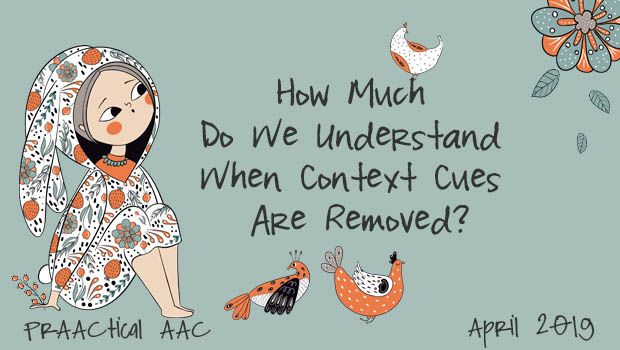How Much Do We Understand When Context Cues Are Removed?

Have you ever worked with clients who could benefit from AAC but resisted using it because they don’t realize that other people can’t understand their speech? Or a family who resists AAC because they perceive their loved one as intelligible when they are actually depending on the context to help them decipher the message? Have you ever worked with service providers who disagree on just how comprehensible their client’s natural speech really is?
It doesn’t happen often, but there are occasions when it can be helpful to remove context cues from the mix and take a hard look at how well we understand someone’s natural speech. Formal testing may certainly play a role here, but informal assessment activities can also be helpful. Here is a task we sometimes use in these situations.
The Materials
Develop a list of 20 words and/or 20 sentences that will serve as the stimuli. For a non-reader, use pictures of familiar concepts (such as sock, tree, and blue), to test single word intelligibility. Use more detailed pictures, like those from problem-solving tests, to look at intelligibility at the sentence level. For literate individuals, you can create a stack of index cards with the target words or sentences.
The Task
Position the client across from a significant other, who will serve as the communication partner. It’s important that the partner sits facing the client, but positioned so that they CANNOT see the list that the client is reading from (or the stack of pictures if the client is a non-reader).
Have the client read the list of words or sentences. Non-readers will label or describe the pictures.
As the client reads or describes the pictures, the partner writes down what he/she heard.
The Data
When finished with all the items, compare the partner’s answers with the actual things on the list that was read (or to the stack of pictures used by non-readers).
Count up the number of words perceived correctly, and do the math to convert to a percentage. For example, if Sonia heard Bill incorrectly 10/20 times at the single word level, his intelligibility in this task would be 50% (with a familiar partner, in an unknown context). If Jenna described pictures in 20 sentences containing a total of 100 words, and her mom transcribed 75 of them correctly, we’d record that as 75% intelligible with a familiar partner in an unknown context. (More on the conditions for qualifying speech intelligibility here.)
The results can help us make better decisions on how to proceed but should be shared carefully and with sensitivity. Hearing that your speech is nowhere near as clear as you thought it was, or learning that you actually aren’t understanding your spouse/child/student as well as you thought you were can leave us feeling raw. Clearly, this is something we have to approach thoughtfully.
Ultimately, though, these data, along with information from significant others and results of additional testing, can help teams make decisions about the role of AAC. Given this information, teams may decide that AAC is likely to play a prominent role or a secondary one used in specific contexts or to clarify communication breakdowns.
Have you used strategies like this to get a better handle on speech comprehensibility? We’d love to hear about your experiences.
Filed under: Featured Posts, PrAACtical Thinking
Tagged With: informal testing, natural speech, speech intelligibility
This post was written by Carole Zangari




1 Comment
We use the Index of Speech Comprehensibility in Children – it takes a little time to put together and administer, but it’s great because you record the child speaking the words. This recording can then be used with a number of communication partners to build up a better picture of who understands them, and in what contexts their AAC strategies may be most necessary.